Foreword / YouTube Video Review
The review on this website is a brief overview and summary of the objective performance of this speaker. It is not intended to be a deep dive. Moreso, this is information for those who prefer “just the facts” and prefer to have the data without the filler. Discussion about the data and my subjective thoughts can be found in my video below.
For a primer on what the data means, please watch my series of videos where I provide in-depth discussion and examples of how to read the graphics presented hereon.
Information and Photos
The recently released Pioneer DJ VM-50 is a powered 2-way Studio Monitor featuring a 5.25-inch midwoofer and a 1-inch dome tweeter in a waveguide. The baffle is made of 4mm thick aluminum which (truly) helps to mitigate baffle resonance; something that was an unfortunate nagging problem in the JBL LSR305P mkII I tested last month. The internal amplifier is a 2-channel Class-D amplifier and each channel supplies 30w to the mid and tweeter, respectively.
This is what the manufacturer says:
The active VM-50 produces clear audio with fast-attacking, punchy bass. The speaker can be tuned to suit the characteristics of any room, making it perfect for recreating a club sound when you’re DJing or providing a flat frequency response when you’re producing music in a home or professional studio setting.
MSRP for the single speaker is approximately $169 USD and $340 USD for a pair.
The back features a variety of switches for boundary settings and basic level adjustments to tailor the sound to the user’s tastes or needs. There is a volume knob and (3) input options: XLR, TRS and RCA phono.
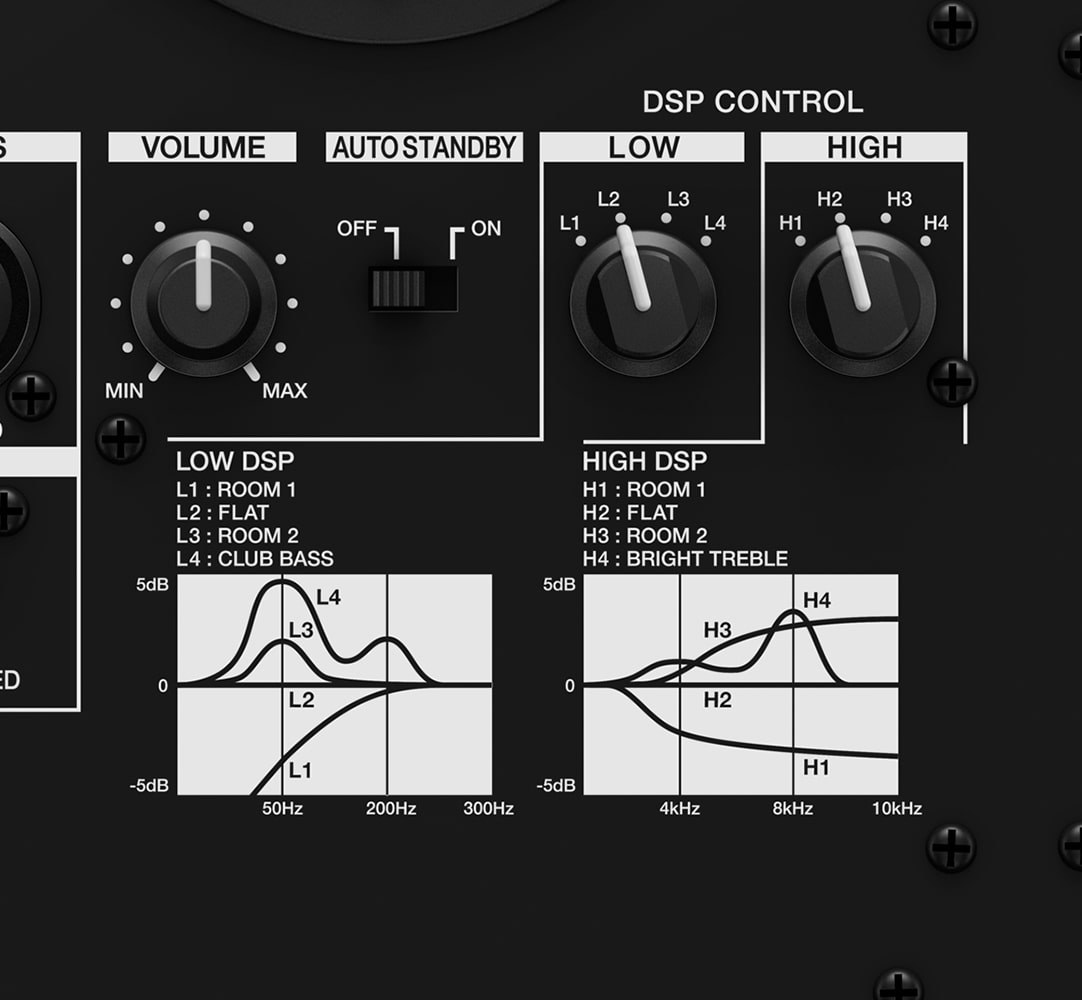
CTA-2034 (SPINORAMA) and Accompanying Data
All data collected using Klippel’s Near-Field Scanner. The Near-Field-Scanner 3D (NFS) offers a fully automated acoustic measurement of direct sound radiated from the source under test. The radiated sound is determined in any desired distance and angle in the 3D space outside the scanning surface. Directivity, sound power, SPL response and many more key figures are obtained for any kind of loudspeaker and audio system in near field applications (e.g. studio monitors, mobile devices) as well as far field applications (e.g. professional audio systems). Utilizing a minimum of measurement points, a comprehensive data set is generated containing the loudspeaker’s high resolution, free field sound radiation in the near and far field. For a detailed explanation of how the NFS works and the science behind it, please watch the below discussion with designer Christian Bellmann:
A picture of the setup in my garage:
While the manual doesn’t say, explicitly, where to position the speaker relative to the ear, there is a graphic that shows the listening plane between the midwoofer and the tweeter/waveguide. I tested this speaker on that plane first and realized it was not ideal. Therefore, the reference plane in this test is at the tweeter (I do provide the results of the other in the extras section). Volume set to max with XLR input. The dip switches were all set to ‘L2’ and ‘H2’ for the “flat” (free field) setting.
Measurements are provided in a format in accordance with the Standard Method of Measurement for In-Home Loudspeakers (ANSI/CTA-2034-A R-2020). For more information, please see this link.
Note: The roll off rate of this speaker is sharp and therefore some noise was unavoidable at 25Hz - even with 4x averaging - which causes a spike in the response here. Ignore the response below 30Hz.
CTA-2034 / SPINORAMA:
The On-axis Frequency Response (0°) is the universal starting point and in many situations, it is a fair representation of the first sound to arrive at a listener’s ears.
The Listening Window is a spatial average of the nine amplitude responses in the ±10º vertical and ±30º horizontal angular range. This encompasses those listeners who sit within a typical home theater audience, as well as those who disregard the normal rules when listening alone.
The Early Reflections curve is an estimate of all single-bounce, first-reflections, in a typical listening room.
Sound Power represents all the sounds arriving at the listening position after any number of reflections from any direction. It is the weighted rms average of all 70 measurements, with individual measurements weighted according to the portion of the spherical surface that they represent.
Sound Power Directivity Index (SPDI): In this standard the SPDI is defined as the difference between the listening window curve and the sound power curve.
Early Reflections Directivity Index (EPDI): is defined as the difference between the listening window curve and the early reflections curve. In small rooms, early reflections figure prominently in what is measured and heard in the room so this curve may provide insights into potential sound quality.
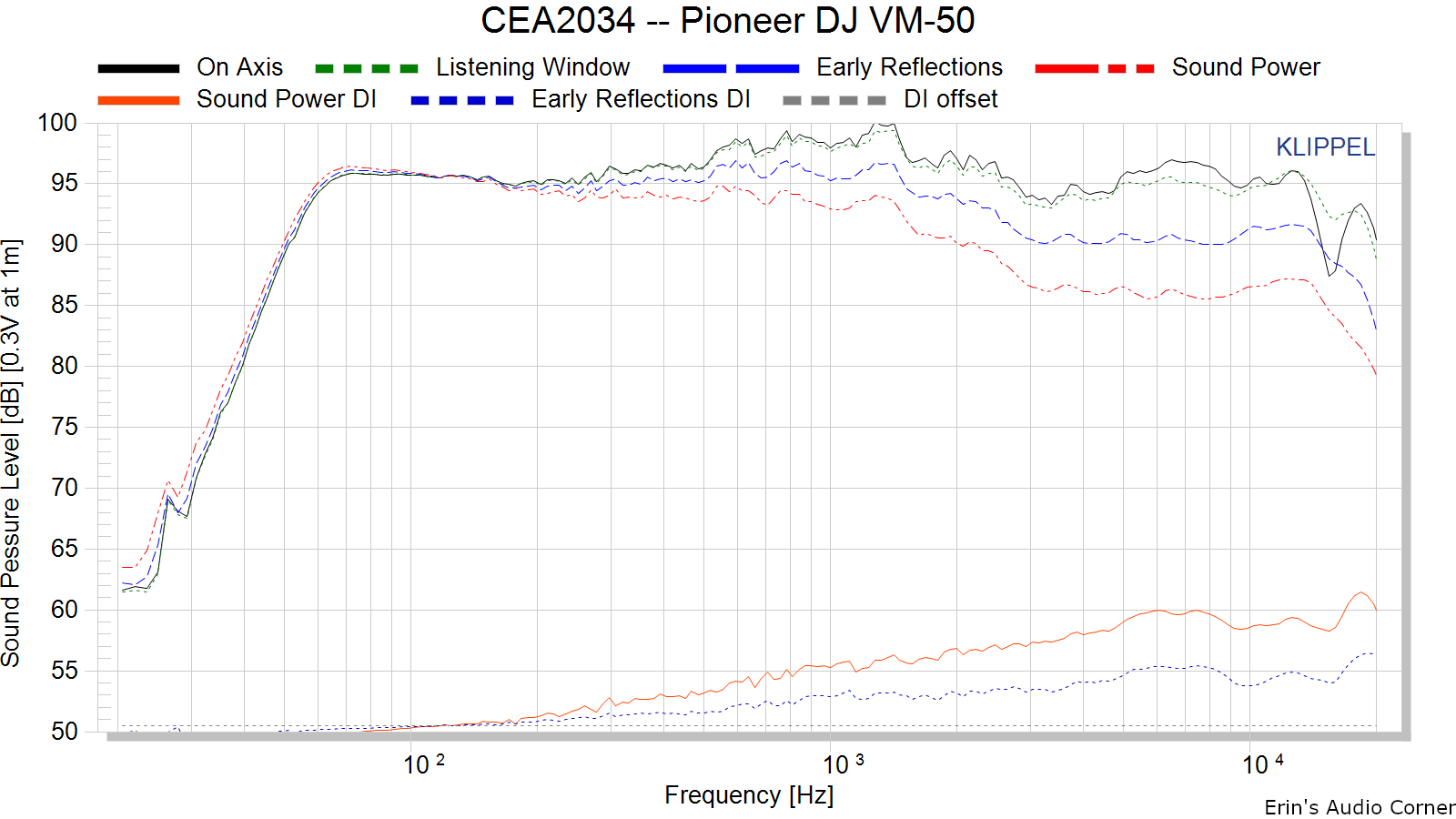
Early Reflections Breakout:
Floor bounce: average of 20º, 30º, 40º down
Ceiling bounce: average of 40º, 50º, 60º up
Front wall bounce: average of 0º, ± 10º, ± 20º, ± 30º horizontal
Side wall bounces: average of ± 40º, ± 50º, ± 60º, ± 70º, ± 80º horizontal
Rear wall bounces: average of 180º, ± 90º horizontal
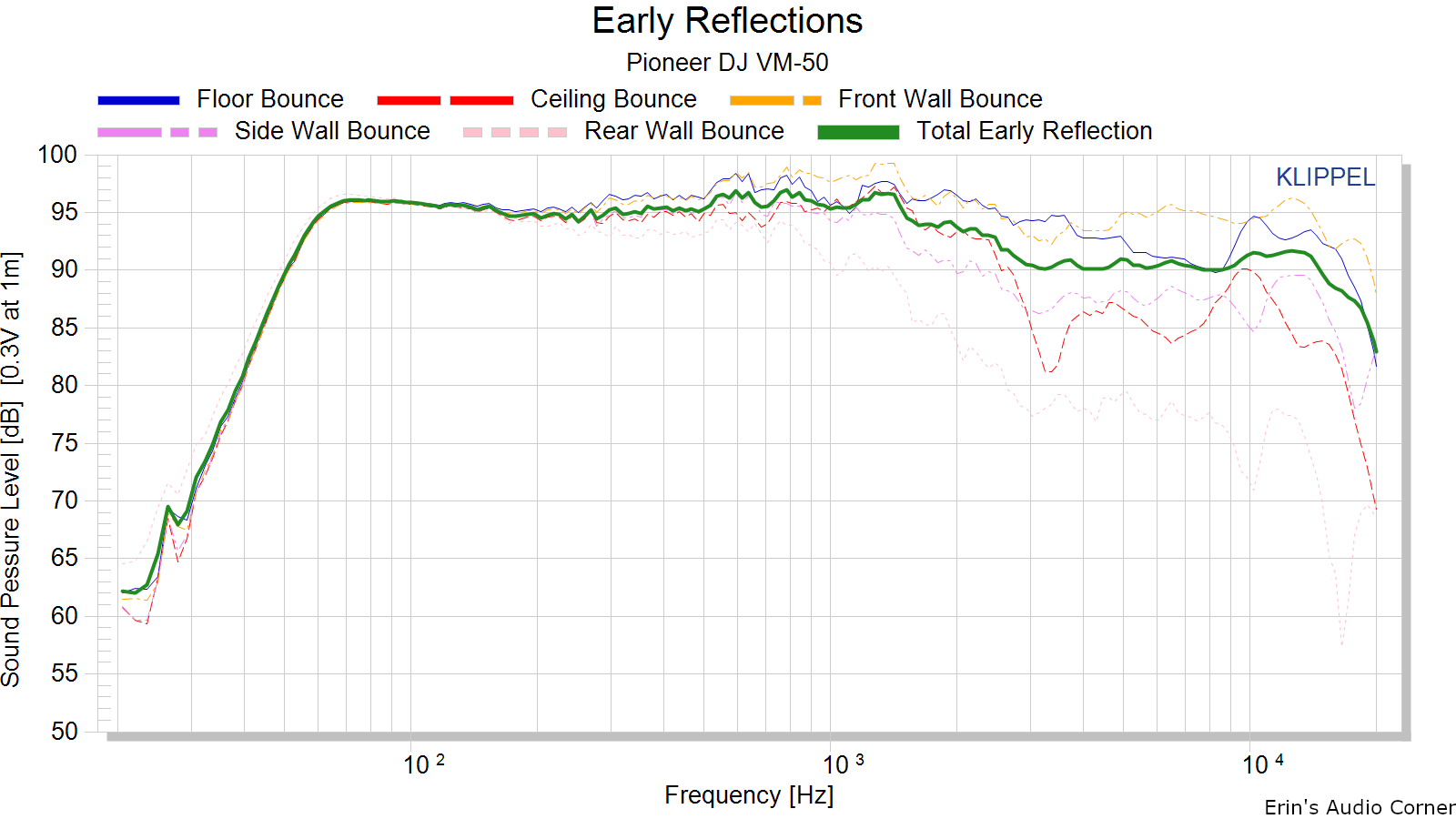
Estimated In-Room Response:
In theory, with complete 360-degree anechoic data on a loudspeaker and sufficient acoustical and geometrical data on the listening room and its layout it would be possible to estimate with good precision what would be measured by an omnidirectional microphone located in the listening area of that room. By making some simplifying assumptions about the listening space, the data set described above permits a usefully accurate preview of how a given loudspeaker might perform in a typical domestic listening room. Obviously, there are no guarantees because individual rooms can be acoustically aberrant. Sometimes rooms are excessively reflective (“live”) as happens in certain hot, humid climates, with certain styles of interior décor and in under-furnished rooms. Sometimes rooms are excessively “dead” as in other styles of décor and in some custom home theaters where acoustical treatment has been used excessively. This form of post processing is offered only as an estimate of what might happen in a domestic living space with carpet on the floor and a “normal” amount of seating, drapes, and cabinetry.
For these limited circumstances it has been found that a usefully accurate Predicted In-Room (PIR) amplitude response, also known as a “room curve” is obtained by a weighted average consisting of 12 % listening window, 44 % early reflections and 44 % sound power. At very high frequencies errors can creep in because of excessive absorption, microphone directivity, and room geometry. These discrepancies are not considered to be of great importance.

Horizontal Frequency Response (0° to ±90°):

Vertical Frequency Response (0° to ±40°):

Horizontal Contour Plot (not normalized):

Horizontal Contour Plot (normalized):
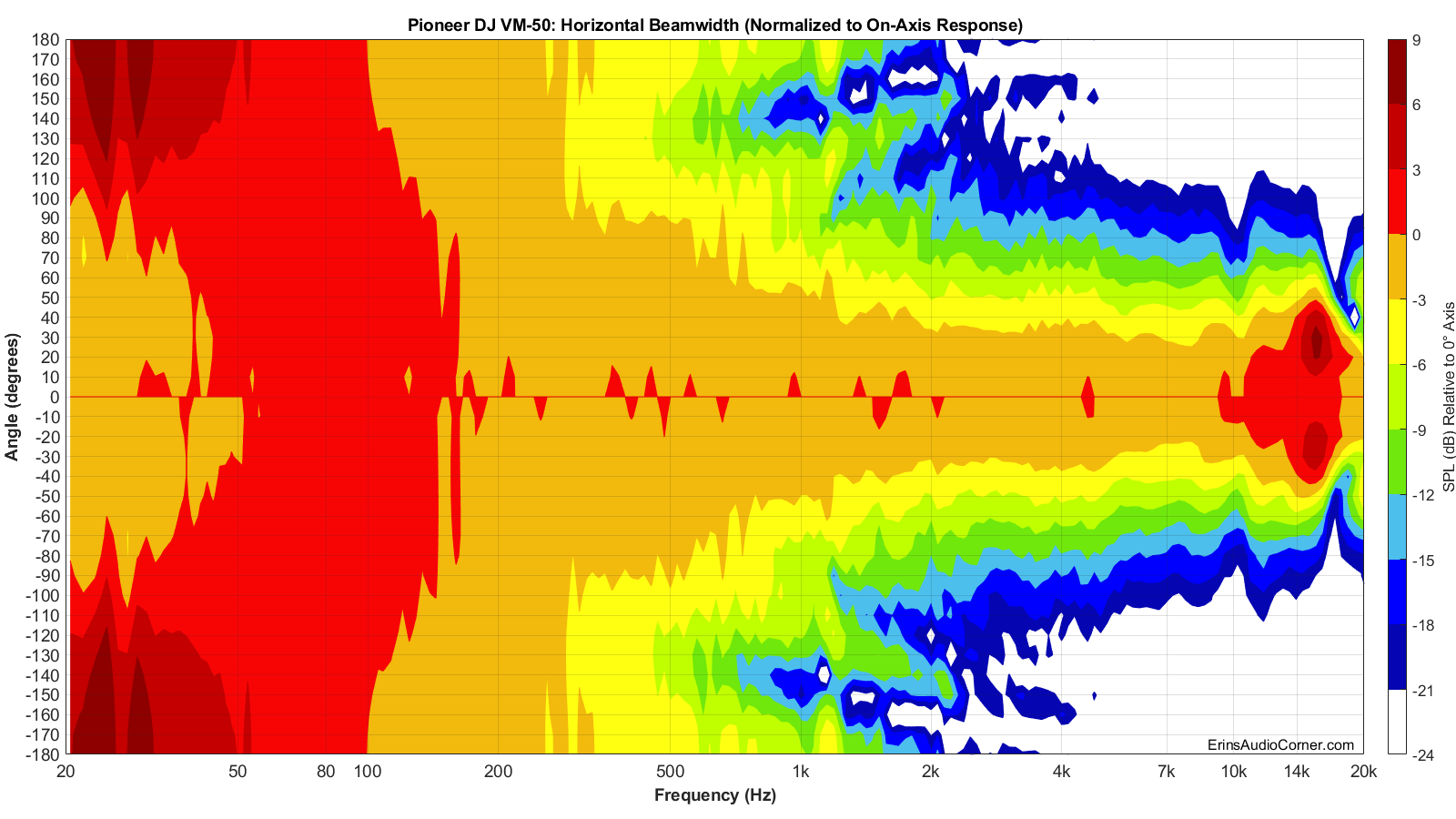
Vertical Contour Plot (not normalized):
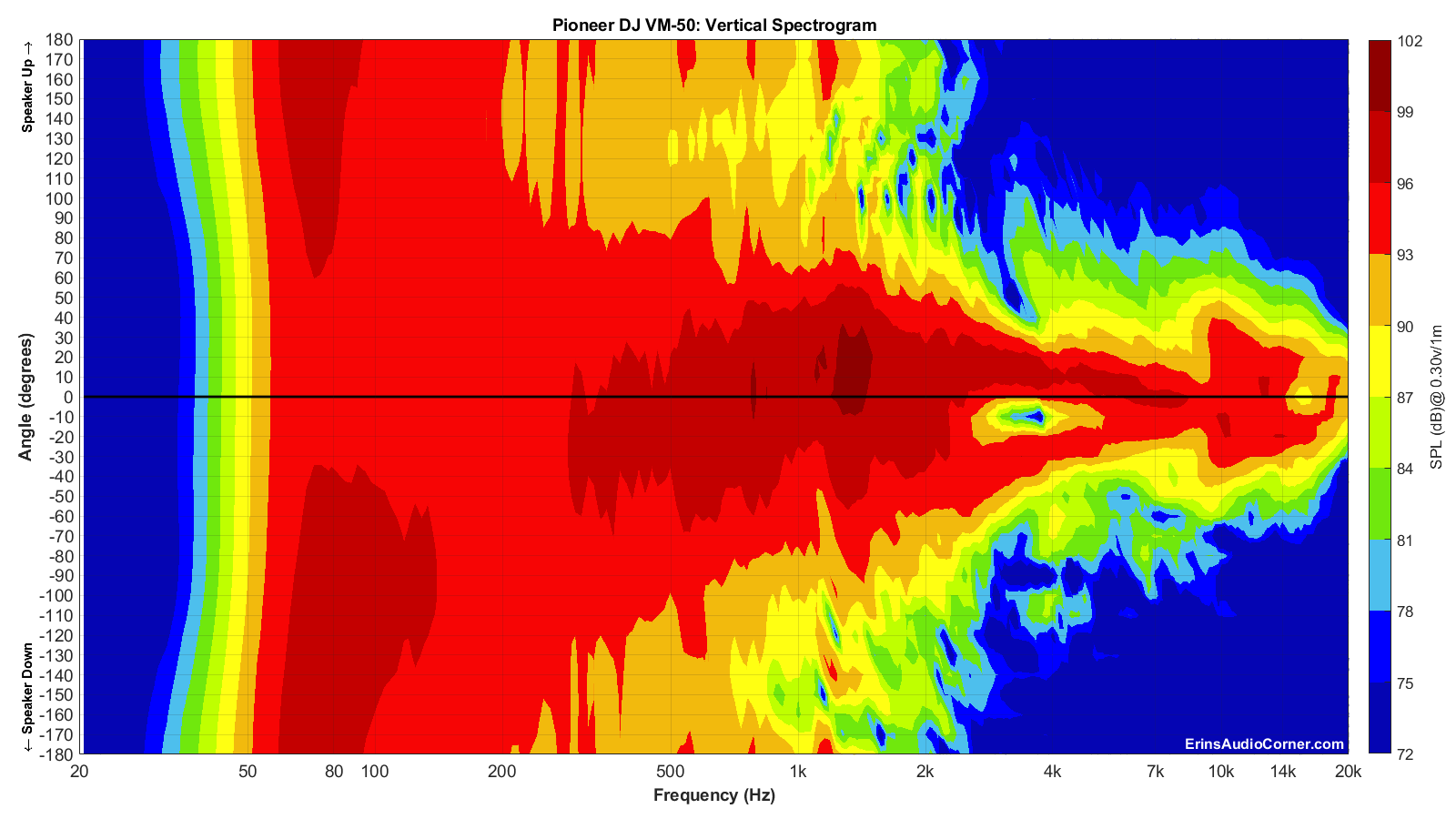
Vertical Contour Plot (normalized):

Additional Measurements
On-Axis Response Linearity
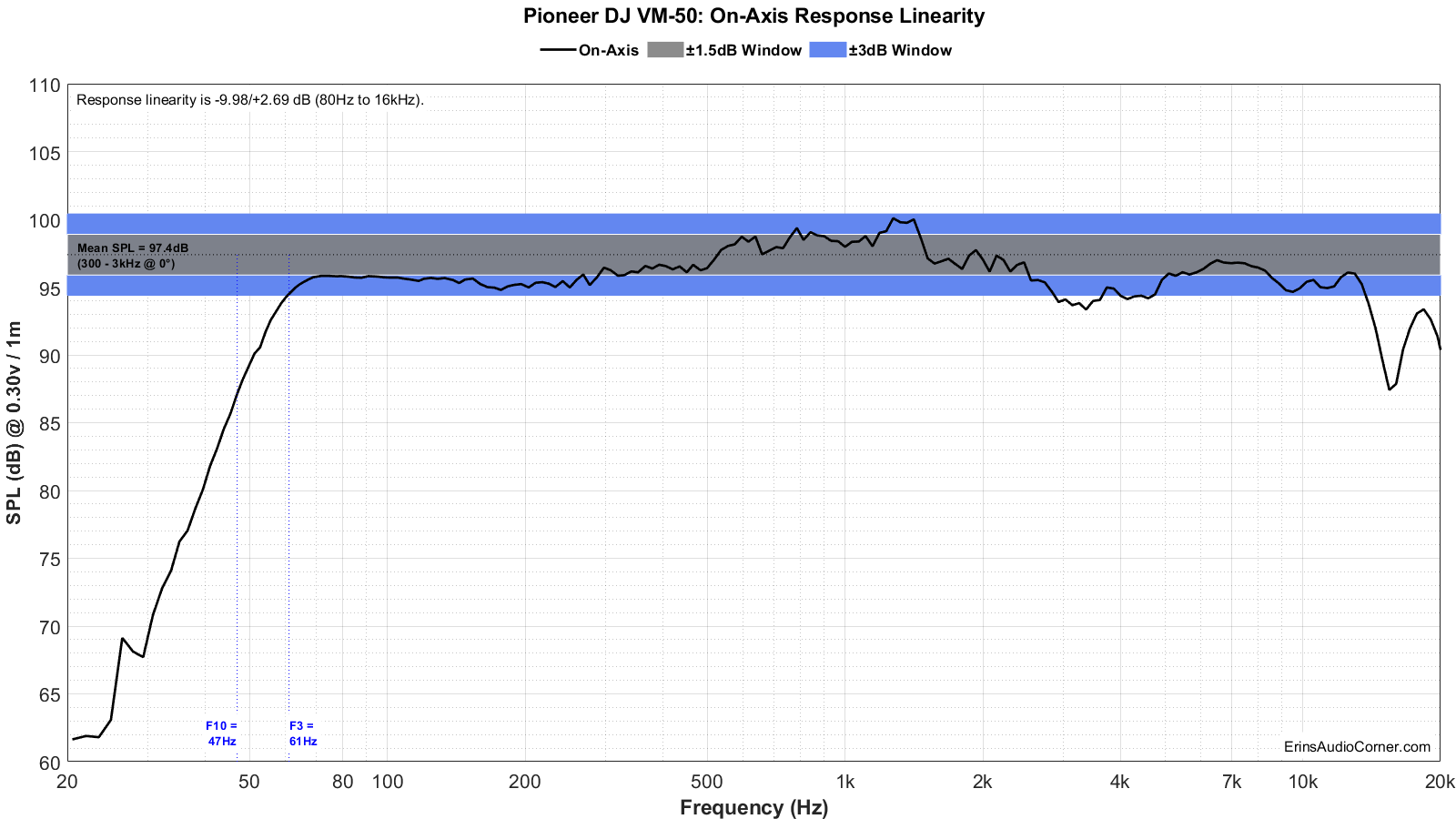
“Globe” Plots
These plots are generated from exporting the Klippel data to text files. I then process that data with my own MATLAB script to provide what you see. These are not part of any software packages and are unique to my tests.
Horizontal Polar (Globe) Plot:
This represents the sound field at 2 meters - above 200Hz - per the legend in the upper left.
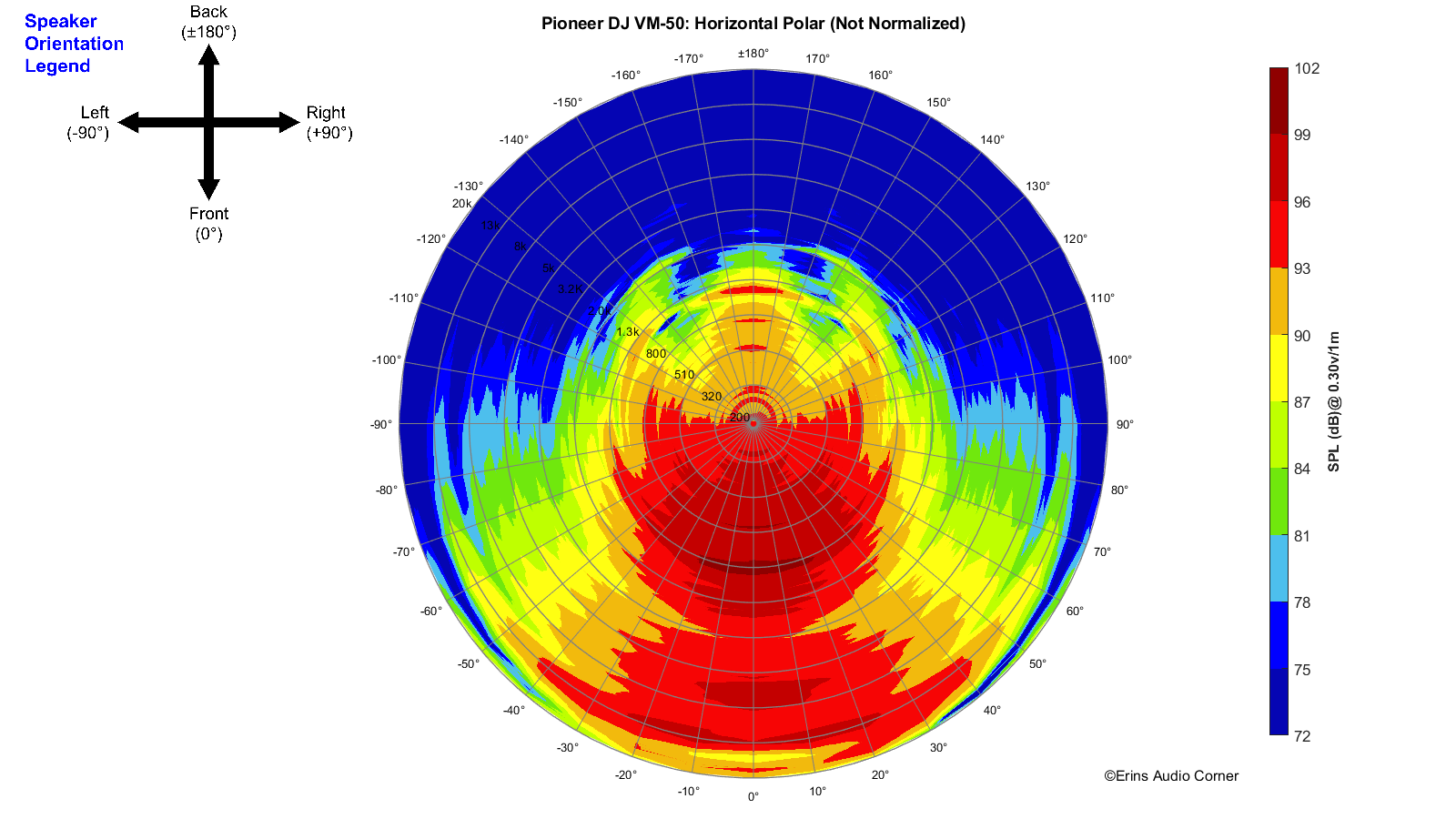
Vertical Polar (Globe) Plot:
This represents the sound field at 2 meters - above 200Hz - per the legend in the upper left.

Harmonic Distortion
Harmonic Distortion at 86dB @ 1m:

Harmonic Distortion at 96dB @ 1m:

Dynamic Range (Instantaneous Compression Test)
The below graphic indicates just how much SPL is lost (compression) or gained (enhancement; usually due to distortion) when the speaker is played at higher output volumes instantly via a 2.7 second logarithmic sine sweep referenced to 76dB at 1 meter. The signals are played consecutively without any additional stimulus applied. Then normalized against the 76dB result.
The tests are conducted in this fashion:
- 76dB at 1 meter (baseline; black)
- 86dB at 1 meter (red)
- 96dB at 1 meter (blue)
- 102dB at 1 meter (purple)
The purpose of this test is to illustrate how much (if at all) the output changes as a speaker’s components temperature increases (i.e., voice coils, crossover components) instantaneously.
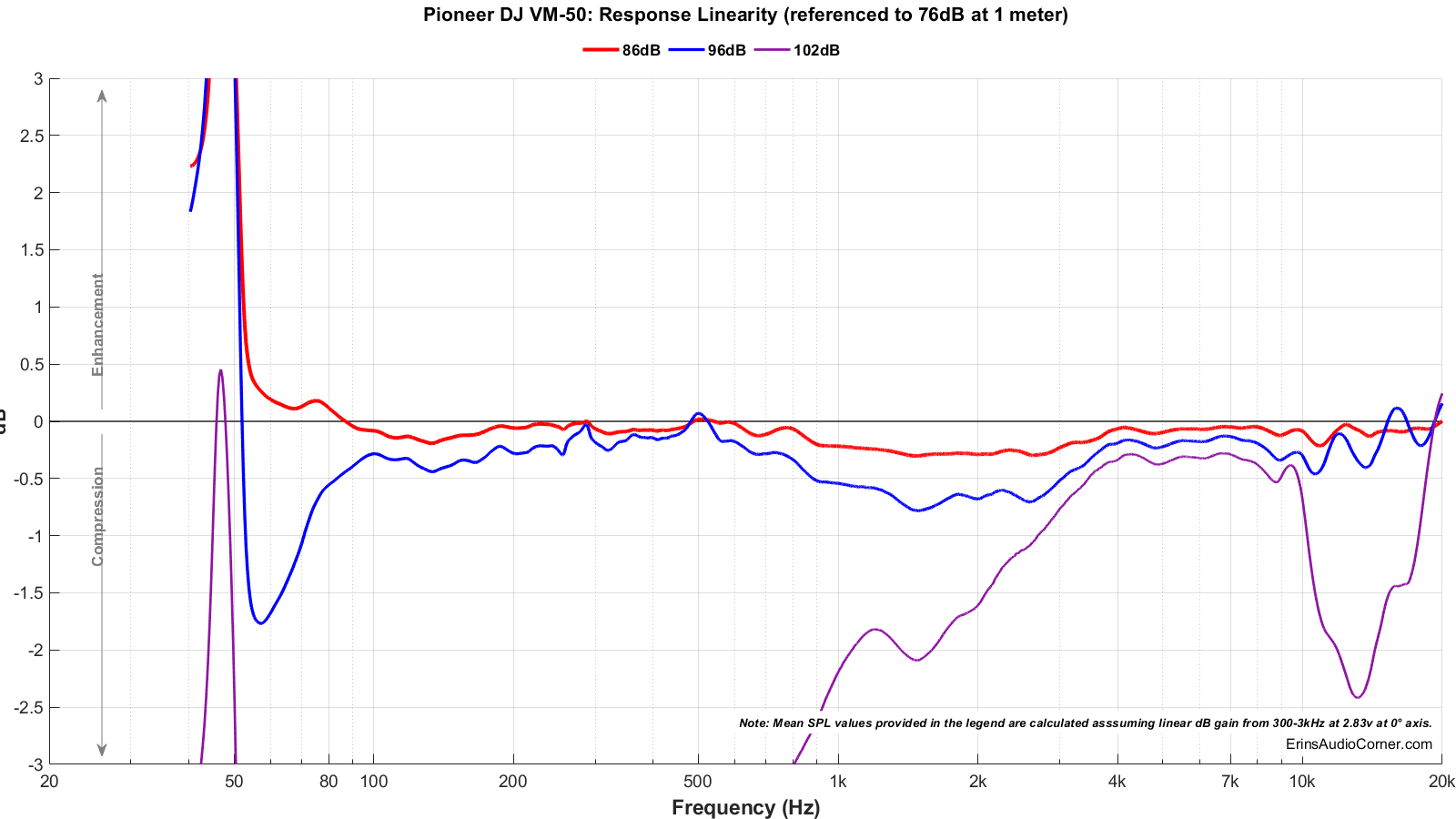
Based on my results above, it is obvious the output is limited (via internal DSP) somewhere above the 96dB @ 1m output level.
Long Term Compression Tests
The below graphics indicate how much SPL is lost or gained in the long-term as a speaker plays at the same output level for 2 minutes, in intervals. Each graphic represents a different SPL: 86dB and 96dB both at 1 meter.
The purpose of this test is to illustrate how much (if at all) the output changes as a speaker’s components temperature increases (i.e., voice coils, crossover components).
The tests are conducted in this fashion:
- “Cold” logarithmic sine sweep (no stimulus applied beforehand)
- Multitone stimulus played at desired SPL/distance for 2 minutes; intended to represent music signal
- Interim logarithmic sine sweep (no stimulus applied beforehand) (Red in graphic)
- Multitone stimulus played at desired SPL/distance for 2 minutes; intended to represent music signal
- Final logarithmic sine sweep (no stimulus applied beforehand) (Blue in graphic)
The red and blue lines represent changes in the output compared to the initial “cold” test.

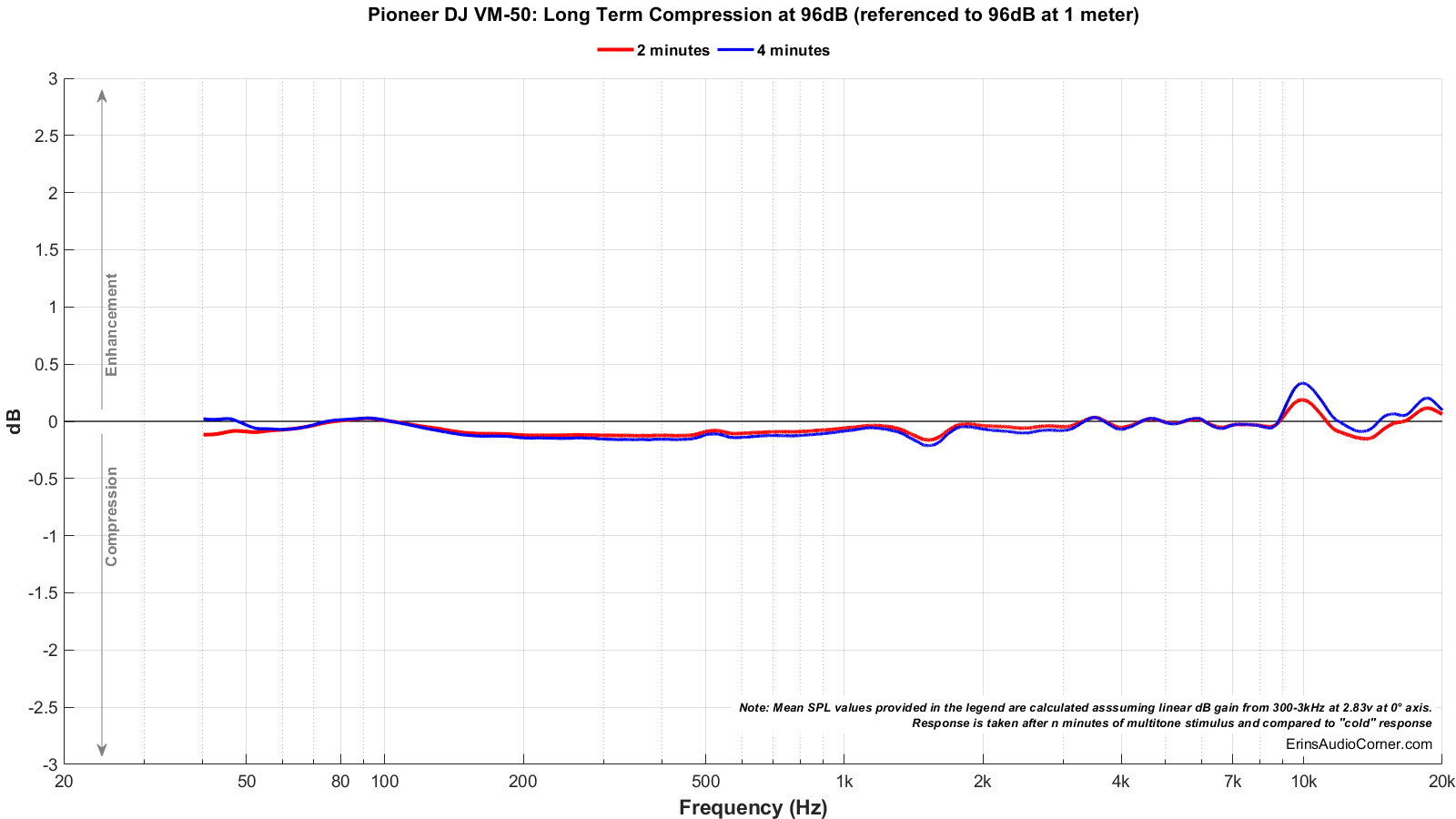
Stuffing the Ports
When looking at the SPIN data and the horizontal data, you can see some resonances around 600Hz, 800Hz and 1200Hz. I thought it was possible the port was resonating and sending energy around the speaker through a mechanical means. So, I tested this theory by measuring the speaker with the port open and then stuffing the port. Per the graphic below, there is no difference in the region I am concerned with. This means the port itself is not the cause.
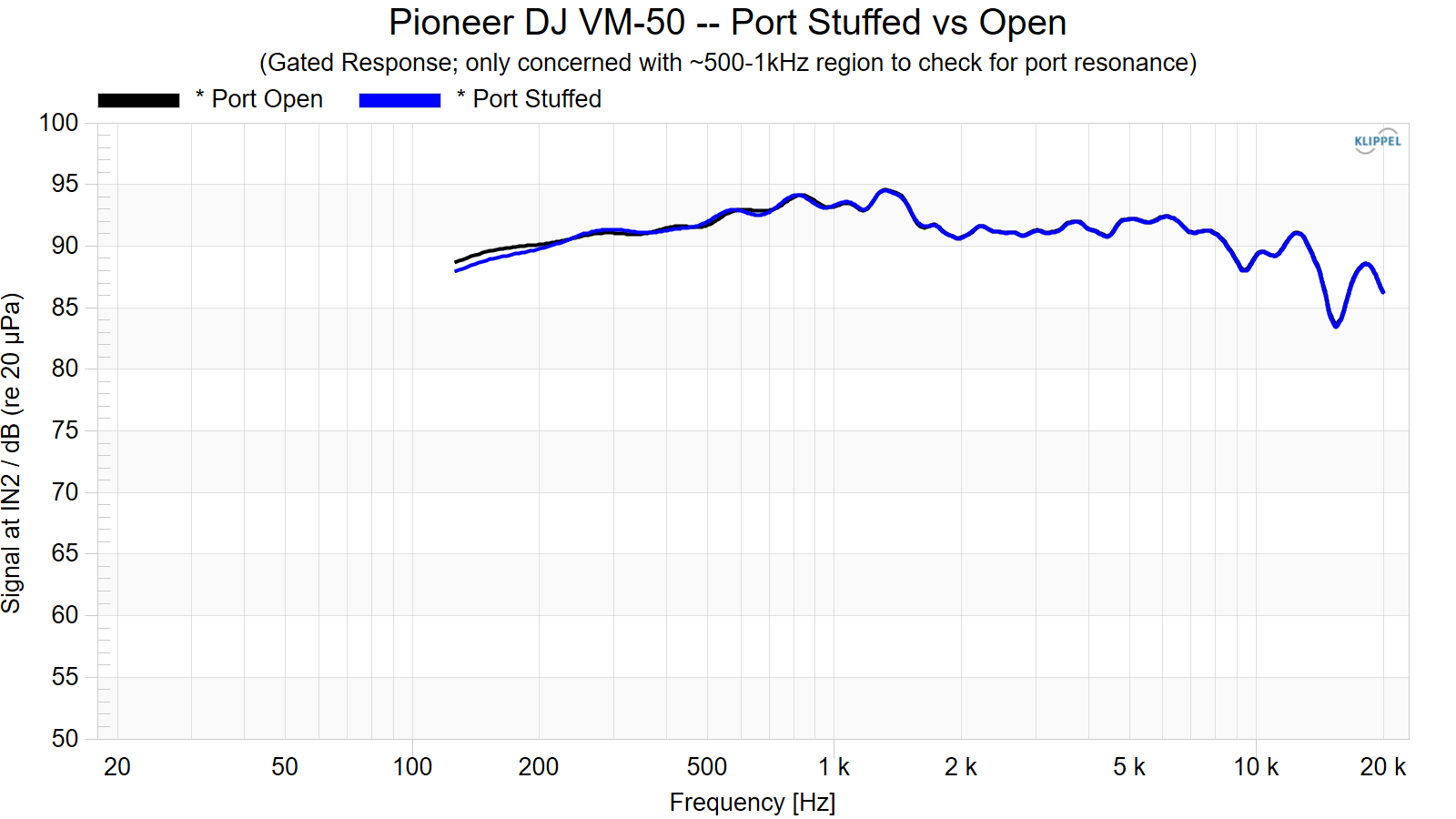
The width of the speaker is about 7.8-inches, but assuming 0.50-inch thick walls, this puts the internal width closer to 6.8-inches. This results in a half-wave of about 1kHz. Figuring the internal dimensions may be a bit off, this leads me to believe what I am seeing is a standing wave inside the enclosure that is simply leaking out of the enclosure in the back. The same assumption applies to all three resonances as the internal dimensions work out to be approximately at these frequencies.
All of that said, these resonances aren’t anything I was actually hearing, at least not to the detriment of my enjoyment of the speaker. Certainly not like other speakers I have experienced resonances with, where in those cases, completely ruined my enjoyment of the speaker. More than anything, it is the sequence of resonances that cause the midrange from 500Hz to 1kHz to be boosted and alter the tonality. In my case, I simply used the built-in EQ of my computer to pad this down about 2dB and it made my musical selection more pleasant to listen to.
Ears at the Tweeter Level
As I mentioned earlier, I initially trusted the manufacturer’s picture which illustrates the listening axis between the midwoofer and tweeter waveguide. Well, as you can see below, that’s not the case. So, keep your ears at tweeter level.
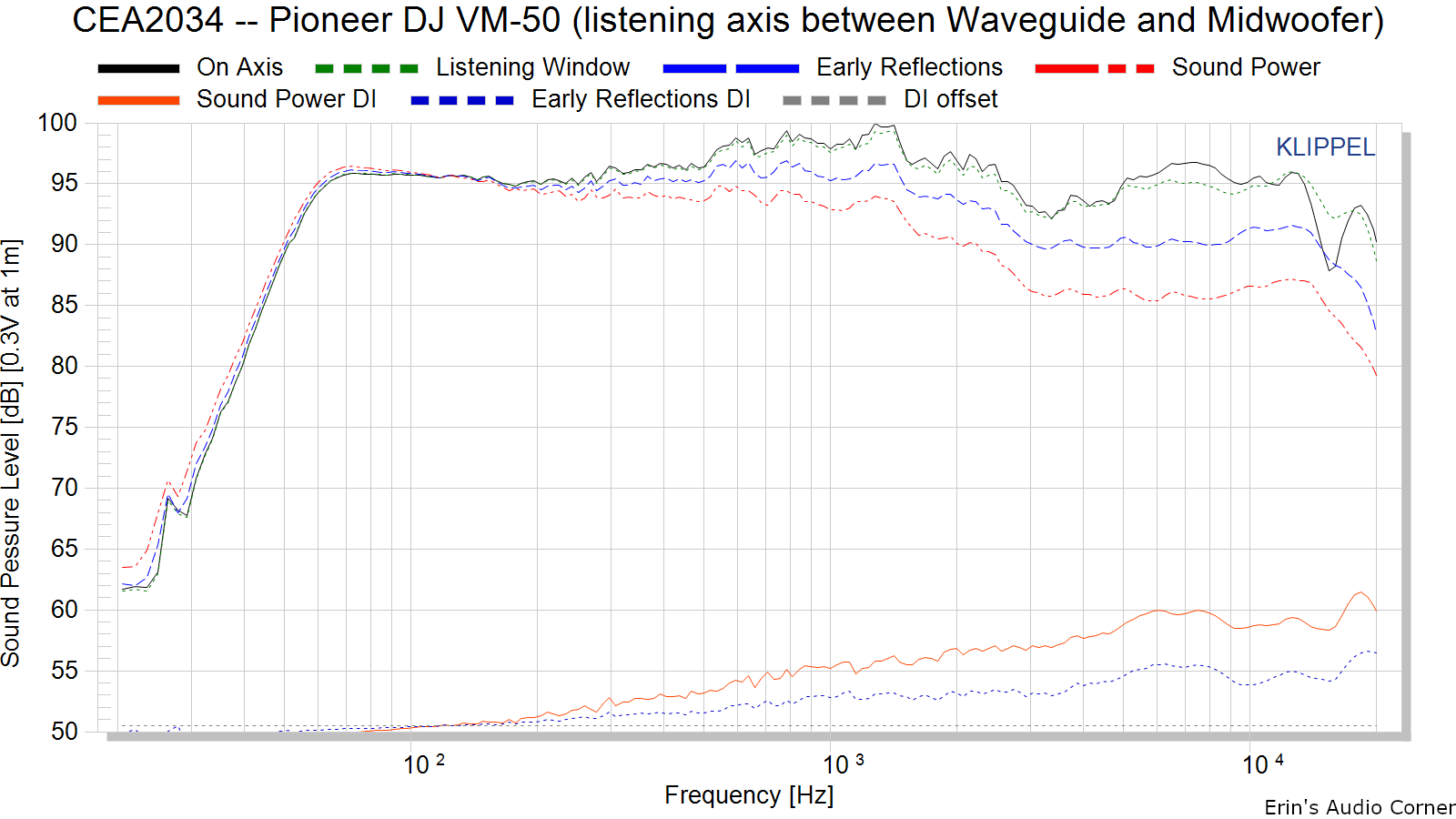
Parting / Random Thoughts
If you want to see the music I use for evaluating speakers subjectively, see my Spotify playlist.
- Subjective listening was primarily at 1.5 meters but varied from 1 to 3 meters. Subjective listening was conducted at 80-95dB at this distance. Higher volumes were done simply to test the output capability in case one wants to try to sit further away.
- The front port means you have more ability to move these speakers in to the prime spot for your needs. And thanks to the dip switches you have more ability to place the speakers where you need; whether free standing, near a wall or on a console.
- There is zero mechanical noise from these speakers (pops, over-excursion, vent noise) even at higher volumes. However, these are intended to be used as nearfield monitors in the 1-2 meter range. Going past this will naturally mean you’ll need more volume and if you are listening at absurd levels you will certainly run in to the built-in limiter throttling the output as I showed in my linearity test.
- When listening, I noticed the HF tends to sound brighter the closer I was to the speaker. This is expected as you are getting less room interaction and more of the direct on-axis sound.
- The bass on these speakers is really quite surprising. As I said above, you can’t crank them because the limiter kicks in and cuts the bass. But at moderate volume (80-85dB at 1-2 meters) the bass is more than sufficient and is really quite well blended. With the f3 at 61Hz, the bass extends low enough into the kick drum region where there is solid punch. Bass guitars sound neutral (other than the 500-1kHz region; see below). There is no resonance in the lower vocals that I’ve experienced from other speakers.
- The treble region looks low, but remember that you have that 500-1000Hz bump. If you flatten that out then the treble is mostly in-line with the rest of the response. Though, the 3.5kHz-centered dip does result in a sound that may not have as much “bite” as would be expected.
- Hiss: Most budget powered speakers have a good deal of hiss that comes through them. While these do have some, I can say that it wasn’t a problem at my listening distance. Maybe if my room were dead silent and didn’t have a computer fan running quietly in the background, I would have heard the hiss from the speakers more. But as it was, I don’t have any complaints.
- Positioning: Horizontally, the 0° axis has a dip (presumably) from the bar grille. If you want, you can toe the speaker in or out a little bit to resolve this. Vertically, you definitely do not want to go below the tweeter axis. The vertical globe plot shows a signficant hole in the response doing this. Even just 10° below the tweeter axis results in a huge dip in response at 3-4kHz. Placing your ears above the tweeter line by about 10° may actually work better.
I do want to mention this, though: Pioneer states these have “flat frequency response”. We know that’s a farce.
This is a case where the data does tell an accurate story and we can see that this is definitely not “flat”. It would be easy to dismiss the speaker. Though, when you consider the price and how they are most likely to be used, these speakers are actually pretty good. These aren’t a “home theater” speaker and I can’t imagine anyone would use them in that fashion. Most will use these as computer speakers or with a mixing board. Both of which will almost undoubtedly provide the user with some EQ. Objectively, the 500-1000Hz region’s bumped up output is problematic but it doesn’t ruin the experience. Though, to some degree, the sound does suffer from this. However, if you have the means to add some EQ (I did with Apple Music’s little 1-octave EQ) then you can really transform these speakers into a great budget monitor. I did this and I enjoyed the speaker more as it seems to get rid of both a “forward” sound and “thick” upper vocal. I would personally take them over the JBL 305Pmk2 because of the front baffle resonance issues I had with the JBL.
My recommendation? Buy these, toss a couple bands of EQ from 500-1kHz to bring this down via your music app or mixing board. Try some adjustments in the high frequency region to see what works best for you. And then call it a day.
Support the Cause
If you like what you see here and want to help support the cause you might be interested in joining my Patreon, here. You can also contribute via PayPal (the big yellow button below).
Your support helps me pay for new items to test, hardware, miscellaneous items and costs of the site’s server space and bandwidth. All of which I otherwise pay out of pocket. So, if you can help chip in a few bucks, know that it is very much appreciated.
Alternatively, if you’d like to purchase these speakers, please consider using my B&H Pro Audio affiliate link below. It yields me a small commission at no additional cost to you and allows me to keep providing you with some cool data to make educated purchase decisions!
You can also join my Facebook and YouTube pages if you would like to follow along with updates.